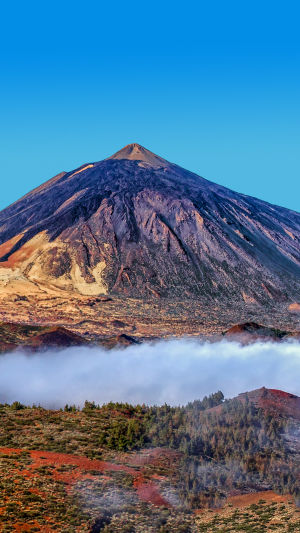Volcanoes are geomorphic landscapes formed by volcanic eruptions, consisting of lava and volcanic debris, and typically have a conical shape, consisting mainly of volcanic cones, craters, and vents.
Volcanoes can be divided into six categories: shield volcanoes, cinder cones, composite volcanoes, lava domes, lava plateaus, and mid-ocean ridges according to the eruptive material and volcanic topographic features; and three categories: active, dormant, and extinct volcanoes according to the eruption time.
Trölladyngja, the largest shield volcano in Iceland, is located in the northern highlands of Vatnajökull National Park.
At 1,468 meters above sea level, the volcano is the tenth-largest mountain in Iceland. It is about 600 meters from the surrounding Ódáðahraun lava field and desert. It is 10 kilometers in diameter and is shockingly large. The oval-shaped crater is 1,500 meters wide at its widest point and 100 meters deep.
Trölladyngja is still active and its last eruption was in 1961. Trölladyngja is closely monitored by Iceland to ensure the safety of residents and visitors.
The shield volcano is formed by highly mobile lava pouring in all directions from the crater, flowing a long way before solidifying, thus giving the peak a unique gentle slope.
In addition to these, there are some of the world's more famous volcanoes.
1. Pacaya
Pacaya is an active composite volcano located in Guatemala and is one of the most active of the country's 33 volcanoes. It is approximately 20 kilometers in a straight line from the ancient city of Antigua, a World Heritage Site, and the international airport of La Aurora, the capital of Guatemala.
Pacaya volcano first erupted 23,000 years ago and has erupted at least 23 times since the Spanish colonization of Central America in the 16th century. After a century of dormancy, it became continuously active again in 1965. Most of its eruptive activity is of the Strombolian type, but sometimes Pliny-type eruptions occur.
2. Mount Yasur
Mount Yasur is located on Tanna Island in the South Pacific Ocean of Vanuatu. 361 meters above sea level, but with many craters within 400 meters, Mount Yasur is located in the seismic zone of the Pacific Rim volcanic belt and is one of the most active volcanoes in the world.
When the volcano erupts, hot lava hisses and slaps the crater, accompanied by the lava thrown into the air. Tourists are more likely to rush to watch this shocking scene before dawn and feel the excitement of the heat wave coming up close and personal without the protection of the fence.
3. Colima volcano
Colima volcano is located in a remote and sparsely populated area of the state of Colima in western Mexico, about 500 kilometers from Mexico City and at an altitude of 3,860 meters. Colima volcano is one of the most active and potentially destructive active volcanoes in Mexico, having erupted 25 times in the last 500 years. It is known as the "Volcano of Fire" and the "Flaming Volcano".
4. Quilauvia Volcano
Quilauvia Volcano is an active volcano in the Hawaiian Islands and is one of the five shield volcanoes that make up the island of Hawaii. The volcano has been erupting since 1983. A large number of tourists come here to see the spectacular eruption of the volcano at sunset.





